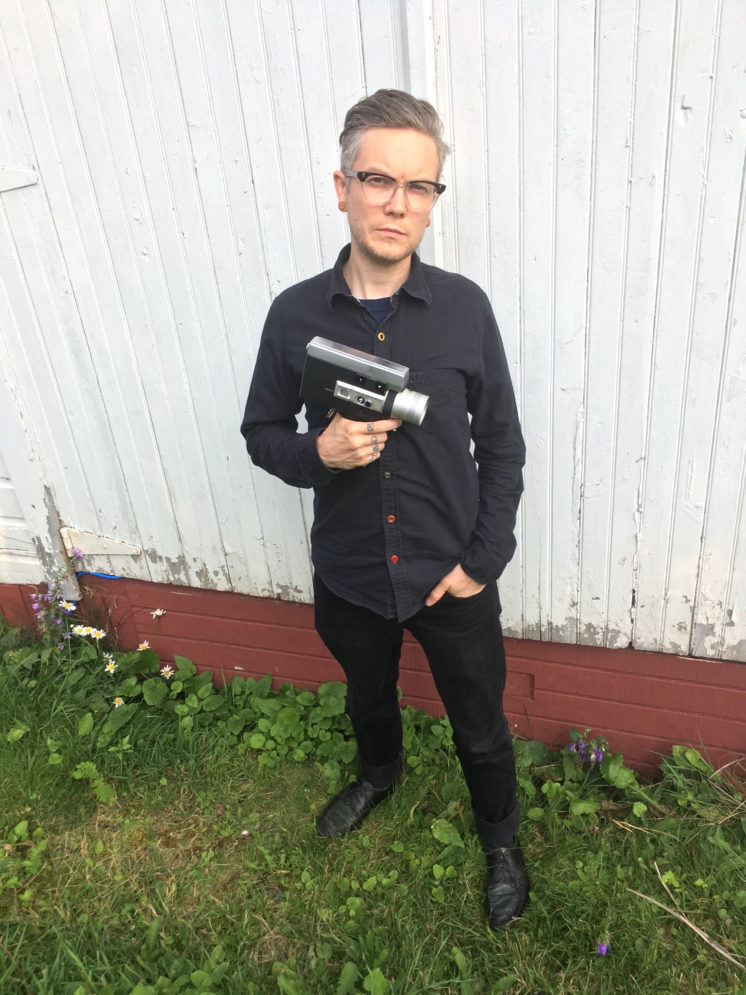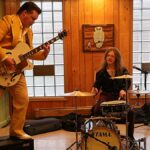Selective Focus: Allen Killian-Moore
Allen Killian-Moore is a filmmaker who recently released a new experimental project in collaboration with the music of Minneapolis-based Humbird for her new single, “On the Day We are Together Again.” His work takes advantage of the imperfections of film and video — the grain, dust and scratches, pixels, flickering, varied frame rates, and they become an important part of the images. This week in Selective Focus, Allen talks about his process and the experiences that have influenced his work.
“On the Day We Are Together Again” Music by Humbird, film by Allen Killian-Moore
AKM: I am a Neurodivergent moving image artist (film and video), writer, curator, still photographer, visual artist, and performer. For this interview, I’ll be focusing specifically on my moving image film and video art.
Back in the day, just post-high school, I was exploring painting, illustration, and graphic design. I always had it in the back of my head somewhere that I would do some kind work in film, though I didn’t yet have a sense of what that might look like. It was when I stumbled into a screening of an Andy Warhol film, one of his series of “screen tests,” that a light went on. I saw that film and video could be approached from the standpoint of contemporary art, as opposed to commercial linear cinema.
From there, I went on to explore the history of avant-garde film and video art including artists like Maya Deren, Margaret Tait, Jonas Mekas, Chris Marker, Santiago Alvarez, Vito Acconci, Shirin Neshat, Marie Menken, and so many others. Through this exploration I was able to eventually find my own approach to avant-garde cinema, and I developed my own particular language within the medium of moving images. I started off working exclusively on film, then switched to video for a time, and ultimately found ways to combine the two (film & video), along with still photos as well, shooting with outdated video cameras, HD Cameras, old vintage film cameras, and old or expired analog film stocks of various kinds.
As a vegan, I’ve very recently made the switch (when shooting film rather than video) to shoot entirely on either expired film stocks, or on old stock that was discovered abandoned in a freezer somewhere that is still entirely viable and like-new (there’s a surprising amount of this old but still viable film if you know where to look). Film emulsion is made of gelatin, which is an animal product derived from industrial animal agriculture, so I don’t want to support that industry if I can avoid it. I’ve found that using old stock and expired film is a way of saving already existing film from the landfill, and of avoiding purchasing new film that is directly derived from large scale industrial animal farms. I’m also looking into the emerging field of vegan film which was recently designed by a chemist in England using plant derived (rather than animal) gelatin to produce a viable film emulsion.
I’ve been exploring film and video for around 17 years, but I first starting having gallery shows and public moving image art screenings around 2010. I did have a piece called the Essence on national television in 2007. It aired on the new defunct Current TV network as a short between some of the longer programs on the network. I shot and edited it on 16mm reversal film stock, and I also included some direct-animation (hand drawn) abstract parts that were drawn directly on clear film leader and then spliced into the finished film. Then, I transferred that finished analog film to digital video. The Essence selected by the viewing audience through an online voting process and as a result I received an artist stipend along with national airtime. That was probably my first significant public screening, but things got rolling more prolifically around 2011 with my first solo gallery show at Fill In The Blank gallery in Chicago. Typically, I prefer to show my work in an actual venue, either an installation in a gallery setting, or screening it at a micro-cinemas and ad hoc artist spaces. Those kinds of opportunities are of course on hold for now, given the global pandemic we are presently experiencing.
Being an artist filmmaker, rather than a commercial production filmmaker, means that I often fulfill either all or the majority of roles when making a film including cinematographer, editor, director, writer (if there’s any writing), producer, and sound designer. I have also processed some film myself, though I’ve worked with a variety of labs to process my film as well. It can be challenging to navigate all of these roles, even on what might seem at first glance to be relatively small film. I often liken my work to assemblage artists like Louise Nevelson who go out into the world and gather objects which they bring back to the studio. From there, they’ll sort through what they’ve got and choose different parts for different sculptures, often cutting, bending, or otherwise modifying those various parts to fit the feeling and meaning of their final sculpture. And sometimes they also add bits that they’ve designed themselves to complete their pieces.
Similarly, I work in a variety of film and video mediums from from the present and the past in order to capture images gathered directly from the world around me, or in some cases, footage that I’ve directed and designed. Then, drawing from this compendium of my all original footage, I craft moving image assemblage works which embrace an archival-esque aesthetic–in other words, they have the feel of something archival, though they are entirely contemporary. The resulting mesmeric collision of imagery, pixels, colors, film grains, and shades embodies a kind of materiality in my work such that together the images and sounds become associationally expressive, transcending their solitary individual forms, and thus creating a sense of something cohesive in the final work.
As for the rewards of my practice, I’m reminded again of a quote from one of the world’s preeminent evolutionary biologists, Richard Dawkins: “There is an anesthetic of familiarity, a sedative of ordinariness which dulls the senses and hides the wonder of existence. For those of us not gifted in poetry, it is at least worth while from time to time making an effort to shake off that anesthetic… We can recapture a sense of having just tumbled into life on a new world by looking at our own world in unfamiliar ways.”
To the extent that my own work participates in that process of shaking off the anesthetic of familiarity, or assisting us in feeling something, or thinking about something anew, I find it to be a worthwhile endeavor. As for my film and video art , I’m always interested in the way that moving images reduce their subjects to the particulars captured on camera and then, when edited down into an assembled framework, in how they cumulatively offer a heightened kind of focus which may reorient our senses, increasing the legibility or meaning that arises from the accumulated images and sounds. This is, I think, is what all art is (or does) at its core, whether we are talking free jazz, or about moving image work, contemporary art opens our focus onto both what matters and what doesn’t; whether it be feelings, thoughts, or ideas, and in that way, my own practice continues to be rewarding.
Most of my work is shown in physical spaces such as micro-cinemas, art galleries, and theaters, though I do have some things online currently.
In April of this year, I received a grant from Springboard For The Arts to curate an online installment of Saltless Sea Cinema which is an avant-garde film and video program that I curate in Duluth. Usually, it happens at a physical venue, but in response to COVID-19, I’ve decided to make this particular screening virtual. The hour long program includes my 16mm film, Permanent State of Exception, along with moving image work from a variety of other avant-garde film and video artists. The new film program is called Quarantine Cinema and it is available to watch on my website through the summer.
Additionally, my feature length experimental documentary, Desolation Slow, which was filmed in Utah around issues related to homelessness, abandonment, and geography, can be purchased on a limited edition DVD from the Chicago based distributor, 1980 Records, on their website:
You can view a short preview trailer for Desolation Slow here:
My film, Permanent State of Exception is also available for institutional rental or collector purchase from NY-based New American Cinema Group via their Film-Makers’ Cooperative catalogue.
To get a sense of the scope of my work, whether it be my moving image art or other areas of my arts practice, check out allenkillianmoore.com.
I am working on a new film featuring the art of Minneapolis based artist Tia Salmela Keobounpheng (aka Tia Keo). She received a grant from the MN State Arts Board to install a project called Unweaving, a large scale public art installation at Gichi-Ode Akiing park in Duluth. Her installation will explore an era known as the Karelian Fever which was a time when Finnish immigrants left Minnesota, returning to Europe to work for Stalin, and when subjected to Stalin’s brutality, they were forced to flee. So, my film, as per my usual practice, will be shot on a wide variety of video and film formats, and will employ the experimental forms of moving image art to poetically document the installation of Tia’s Unweaving work in Gichi-Ode Akiing park.
My film will then go on to be installed in the Art History Gallery in St. Paul at UST during the spring of 2021 as part of the Unwoven exhibition. It will be installed alongside Tia’s work related to her Unweaving public art project.
Beyond that, the challenges of life remain. How does one balance the other demands of life with one’s art practices? How does one balance ethics with contemplation and the human propensity for error? I think the appropriate metaphor is navigation. Sometimes we navigate via a long process of consideration, and other times we take more immediate action in order to achieve something, or to avert disaster, or to carefully plow through some wreckage that lands in our path. In any event, artful navigation requires an engaged mind and a steady focus.
ARTIST BIO
Allen Killian-Moore was born the fall of 1981. He spent his young adult life as an itinerant artist-activist, taking up residence beneath a staircase, in a van, on a porch, in a moldy basement, and behind an old sofa, among other unsavory spaces. Following more than a decade of rambling, he eventually landed on the icy edge of Lake Superior in Duluth, Minnesota. Allen is a Neurodivergent moving image artist, curator, writer, photographer, visual artist, and performer. His work explores coexistence in many forms—individual and collective, social and political, life and death. Allen’s moving image work has been praised for its reflective quality and raw poignance, with critic Stephanie Burke for Art Talk Chicago describing Allen’s video installation, Body Tempest, as “Physically much more than I expected… Killian-Moore enshrouded the projection in a hobo circus-revival tent, blood red and ominous. The tomb-circus-house blur all served to heighten the impact of watching such a tragic event unfold through the filter of a single repetitive act, the pulling and contemplation of hair.” In the fall of 2018, Allen was an Artist In Residence at the North Dakota Museum of Art, and he was the recipient of a Career Development Grant in 2018. His feature length documentary, Desolation Slow is distributed on DVD by Chicago based 1980 records, and his short film, Permanent State of Exception is available for institutional purchase through NY based Film-Maker’s Cooperative’s online catalogue. Additionally, Allen is the founder and curator of the Saltless Sea Cinema, an ongoing roaming micro-cinema programming screenings of avant-garde film and video art.
Allen’s film and video work has screened at a wide variety of venues, including Hennepin Theater Trust, FIB Gallery, a solo exhibition at the Duluth Art Institute, and the Joseph Nease Gallery. He’s also had work featured in the annual Chautauqua Art Lab in Saint Louis, and his 16mm film, The Essence, screened nationally on the viewer curated Current TV channel. In addition to moving image work, Allen’s writing, essays and poetry have been published and distributed by Microcosm Publishing, Loach, Whole Beast Rag, and Boneshaker Almanac, among others. Allen’s ode to Duluth’s own Jefferson People’s House worker-coop, Owning The Means of Production, was released by Portland based Microcosm in 2017. Allen’s band, Agassiz Oscillation Ensemble recorded an album called Workplace Democracy, which was released in limited edition on 1980 Records in Chicago.
Recommended Links:
Leave a Comment
Only registered members can post a comment , Login / Register Here
















No Comments